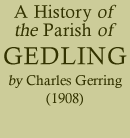< Previous | Contents | Next >
List of Officers, &c., of Gedling Parish Church.
(1908).

Group of clergy, church officers, &c.
Rector:—The Rev. The Honble. A. E. Bertie, M. A.
Curate:—The Rev. T. W. Peck, B.A.
Wardens:—Messrs. R. Butler and A. C. Wainwright.
Sidesmen:—Messrs. W. H. Blackburn, E. Pratt, James Wright, W. O. Beard, G. Smith, W. H. Knightall, F. G. Bird, E. H. George, J. Rutherford, C. Gerring, R. Whitbread, W. H. Heazell.
Ringers:—Messrs. R. Savidge, S. Rutherford, J. Rutherford, C. Bellamy, W. Horsepool, and P. Horsepool.
Choirmen:—Messrs. A. W. Oakland, T. Wain, W. V. Wilding, C. Beard, J. Bryan, W. Nicholson, P. Straw, C. E. Wainwright, E. Pratt, G. Hatherley, J. H. Guyler, F. Banner, J. R. Clements, E. Francis, H. Adams, A. W. S. Simpson, and W. S. Simpson.
Choirmaster:—Mr. Charles Gerring.
Organist:—Mr. Alfred H. Cooke.
Clerk and Sexton:—Mr. Thomas Bellamy.
Just outside the Rectory gates, where now is found a gas lamp, in the midst of a triangular open space, is the site of the old village cross. This particular spot is known as "The Cross." We have spent a considerable amount of time investigating this subject, but no documentary evidence has come in our way, though local tradition is very certain on the point. "Many years ago there was a stone cross at that spot," has been most emphatically stated to us, by at least half a dozen old inhabitants; we can only write what we know, but unfortunately tradition is not history.
Some five years ago we came across a note of Mr. A. Stapleton's, in Local Notes and Queries. As it bears on the subject, we quote it in full. "We have neither documentary nor traditional evidence of any cross having existed at Gedling. Nevertheless, about ao years ago, a sculptured fragment was turned up in the garden at the back of the Chesterfield Arms, not far from the Church, which is viewed as part of such an erection. Luckily it was preserved, and may now be viewed in the vestry, where it is hinged to the wall to facilitate inspection. Here we saw it sixteen years ago (1886), together with a stone coffin and other antiquities. It presents somewhat the appearance of part of a richly sculptured window mullion, and if it really belonged to the village cross, the latter must have been a choice and elaborate example. The fragment is about eighteen inches in length, and, though now somewhat indistinct from age, on one side is seen in relief a representation of the child Jesus in the arms of the Virgin Mary, while on the other side appears the crucifixion, the cross being somewhat curved to conform to the shape of the stone."
Looking up, from the "Cross," one gets a very fine view of the Church.
Another local tradition which has cost much time in investigation, is that one relating to "The Priory."— Without exaggeration, the writer may say that he has referred to every possible book that may have been able to throw some light on this subject, but without result. Though we have Priory Road, Priory Cottages, Priory Building Estate, Priory Mount (the residence of W. Scott Browne, Esq.), nothing definite can be found as to the historical fact of such a building ever being in existence. We will again quote from the Nottinghamshire Guardian Notes and Queries, 24th August, 1901. "We believe there is a tradition to the effect that a Priory once existed on the opposite side of the road from the Church. Of any such foundation, however, no sort of proof appears to be extant. Both local historians and national chroniclers, such as Dugdale and Tanner, are silent hereon, and consequently little or no confidence can be placed in the tradition. If such a place ever existed there is no doubt whatever that some reference thereto would have transpired in the great mass of ancient records now made accessible by the medium of the printing press. The idea possibly originated in Shelford Priory owning one-half the Rectory, to which a manse may have pertained." In confirmation of this surmise see page 33 ante, where it is shown that in 1310 it was ordained that the Vicar presented by Shelford Priory "shall have for his mansion those two areas lying together on the south side of the Church, whereon the Prior and Convent shall build for his habitation, one hall, two chambers, pantry, and kitchen, and a stable for two horses."
